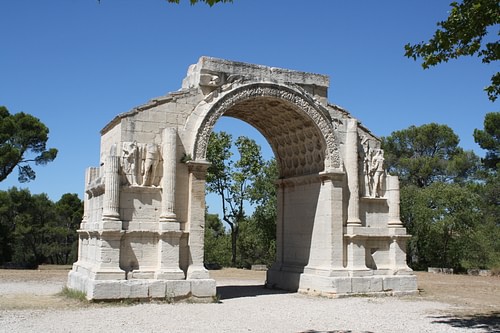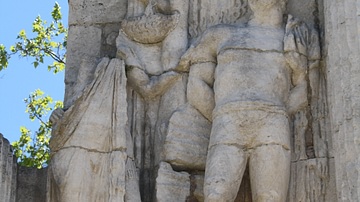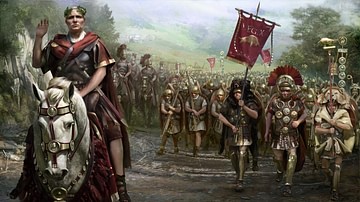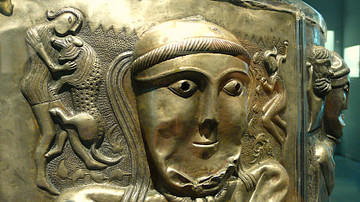
Glanum, located near St-Rémy-de-Provence in southern France, was a Greek and then Roman town which prospered due to its location on trading routes between Italy and the Rhodanus (Rhone River). The town benefitted from a large building project in the Hellenistic period and another spree during the reign of Augustus which furnished Glanum with temples, a theatre, basilica, monumental arch, and Roman baths, amongst other amenities. The town was abandoned in the 3rd century CE but today offers the modern visitor an impressive array of Greco-Roman ruins.
Historical Overview
Glanum was first settled by the Celts, specifically the Salyans (Salluvii), from the 7th to 6th century BCE. Indeed, the town's name derives from Glan, a Celtic spring deity who continued to be worshipped at the site into the Roman period. The town grew following an influx of colonists from Massalia (Marseilles) in the 2nd century BCE. Flourishing as a trade centre and noted as a place of healing, Glanum began to mint its own silver coinage (with a bull and a Glanic mother goddess design) and benefitted from a Hellenistic building programme which included a peristyle building, ornamental spring, temple, bouleuterion (public assembly theatre), and several large private villas. The town spread to cover some 20 ha in this period and was protected by a circuit wall.
The Romans took an interest in the town from the 1st century BCE following the Second Salyan War (90 BCE) when the consul Caecilius quashed what would be the last Celtic revolt in the region. The town was razed, but during the reign of Augustus, Glanum once more benefitted from a programme of rebuilding. New monumental structures included an agora, forum, theatre, a curia (council building), basilica and various other public buildings, temples, Roman baths, a triumphal arch, and mausoleum. Outside the town, two aqueducts were built to regulate Glanum's water supply. In addition to new buildings, the town was granted certain Latin privileges, made a full Roman colony in the 1st century CE, and continued to prosper as a trading stop near the Via Domitia.
Glanum's glory days came to an end when it was destroyed by the Alemanni c. 260 CE. The site was then abandoned by the local people in favour of a new location at nearby St-Rémy-de-Provence. Glanum was first excavated in the early 20th century CE and work continues today with some of the temples undergoing restoration.
Architectural Highlights
Triumphal Arch & Mausoleum
Both of these structures, just on the edge of ancient Glanum, have remained above ground since antiquity (unlike the rest of the town). Together they became known as 'Les Antiques' and received such notable visitors as King Charles IX. The monumental arch was built in the early 1st century CE, probably to commemorate Glanum's new status as a Roman colony. The top portion is missing but the statues at the sides remain and depict enslaved Gauls.
The mausoleum tower, which would have once stood alongside many other funerary monuments, dates to c. 40 BCE. It has traditionally been attributed to the three Julius brothers of Julius Caesar's family but the names (Sextus, Lucius, and Marcus Gaius) are probably only coincidental. More likely, they were members of a wealthy local family who, given Roman privileges, took the names of the famous ruling family for purposes of prestige. The square base of the tower has relief panels depicting various scenes from mythology: a battle with Amazons, a cavalry scene, the fight for the body of Patroclus from the Trojan War story, and the Calydonian boar hunt. Above the base is the tetrapylon with an arch on each side with protective heads of Medusa and a frieze running around it depicting Tritons carrying the sun. The top of the tower is a tholos with Corinthian columns and a conical roof.
Sacred Spring of Glan
This spring, associated with the Celtic god Glan and various other female Celtic deities, was believed to have healing properties, and so believers visited Glanum and threw into it offerings such as coins, pottery, and figurines in the hope of curing their ailments. Roman artefacts in the well attest to the fact that it continued to be used even after the Romans took over the site. The well is reached by a paved passageway and down steps beneath a single arch. Opposite the spring a wide stone staircase winds up the hill to a sanctuary, probably once dedicated to prehistoric and then Celtic deities.
Hellenistic Houses
The site has several Hellenistic-period houses built in typical Greek style. The best preserved is the House of the Antae, which has a columned peristyle with a large basin to channel rainwater to a cistern below it via an open stone channel. It also has two unusual square doorway columns topped by Corinthian capitals. The House of the Capricorn had two fine mosaics, one depicting dolphins swimming around a central goat and the other with a geometric design.
The Twin Temples
Two identical temples each have a four column façade. One is slightly larger, and both were built c. 20 BCE in the forum. They were dedicated to the imperial cult and surrounded by a u-shaped colonnaded building (peribolos) to enclose the sacred space. The smaller temple has had a portion partially reconstructed using original pieces as models.
Roman Baths
The thermal baths of Glanum were built in the latter half of the 1st century BCE with improvements made in the late 1st century CE. They have the typical features one would expect to find: a cold room (frigidarium), steam room (laconicum), hot room (caldarium) and a large swimming pool. The latter was fed water via a stone theatre mask, a replica of which is on site. There is also a stone bench still in position along one of the walls.









